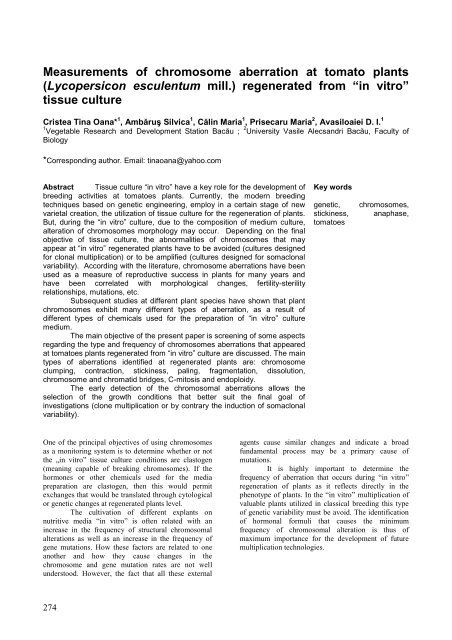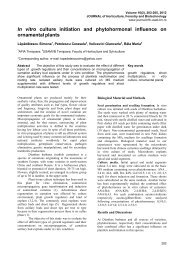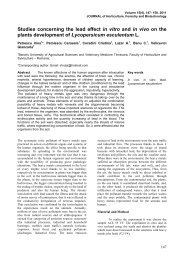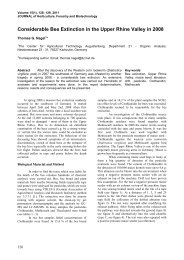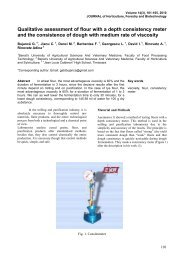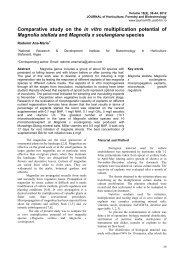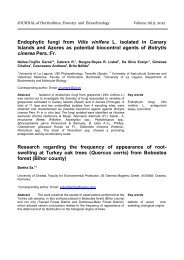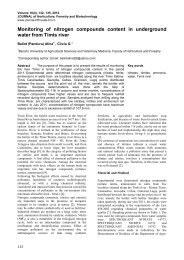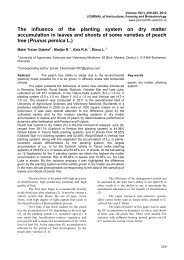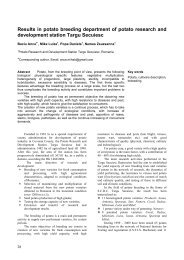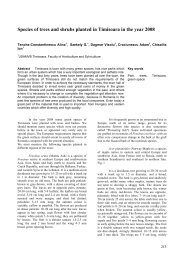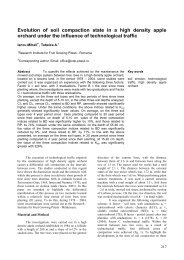measurements of chromosome aberration at tomato plants
measurements of chromosome aberration at tomato plants
measurements of chromosome aberration at tomato plants
Create successful ePaper yourself
Turn your PDF publications into a flip-book with our unique Google optimized e-Paper software.
Measurements <strong>of</strong> <strong>chromosome</strong> <strong>aberr<strong>at</strong>ion</strong> <strong>at</strong> tom<strong>at</strong>o <strong>plants</strong>(Lycopersicon esculentum mill.) regener<strong>at</strong>ed from “in vitro”tissue cultureCristea Tina Oana* 1 , Ambăruş Silvica 1 , Călin Maria 1 , Prisecaru Maria 2 , Avasiloaiei D. I. 11 Vegetable Research and Development St<strong>at</strong>ion Bacău ; 2 University Vasile Alecsandri Bacău, Faculty <strong>of</strong>Biology*Corresponding author. Email: tinaoana@yahoo.comAbstract Tissue culture “in vitro” have a key role for the development <strong>of</strong>breeding activities <strong>at</strong> tom<strong>at</strong>oes <strong>plants</strong>. Currently, the modern breedingtechniques based on genetic engineering, employ in a certain stage <strong>of</strong> newvarietal cre<strong>at</strong>ion, the utiliz<strong>at</strong>ion <strong>of</strong> tissue culture for the regener<strong>at</strong>ion <strong>of</strong> <strong>plants</strong>.But, during the “in vitro” culture, due to the composition <strong>of</strong> medium culture,alter<strong>at</strong>ion <strong>of</strong> <strong>chromosome</strong>s morphology may occur. Depending on the finalobjective <strong>of</strong> tissue culture, the abnormalities <strong>of</strong> <strong>chromosome</strong>s th<strong>at</strong> mayappear <strong>at</strong> “in vitro” regener<strong>at</strong>ed <strong>plants</strong> have to be avoided (cultures designedfor clonal multiplic<strong>at</strong>ion) or to be amplified (cultures designed for somaclonalvariability). According with the liter<strong>at</strong>ure, <strong>chromosome</strong> <strong>aberr<strong>at</strong>ion</strong>s have beenused as a measure <strong>of</strong> reproductive success in <strong>plants</strong> for many years andhave been correl<strong>at</strong>ed with morphological changes, fertility-sterilityrel<strong>at</strong>ionships, mut<strong>at</strong>ions, etc.Subsequent studies <strong>at</strong> different plant species have shown th<strong>at</strong> plant<strong>chromosome</strong>s exhibit many different types <strong>of</strong> <strong>aberr<strong>at</strong>ion</strong>, as a result <strong>of</strong>different types <strong>of</strong> chemicals used for the prepar<strong>at</strong>ion <strong>of</strong> “in vitro” culturemedium.The main objective <strong>of</strong> the present paper is screening <strong>of</strong> some aspectsregarding the type and frequency <strong>of</strong> <strong>chromosome</strong>s <strong>aberr<strong>at</strong>ion</strong>s th<strong>at</strong> appeared<strong>at</strong> tom<strong>at</strong>oes <strong>plants</strong> regener<strong>at</strong>ed from “in vitro” culture are discussed. The maintypes <strong>of</strong> <strong>aberr<strong>at</strong>ion</strong>s identified <strong>at</strong> regener<strong>at</strong>ed <strong>plants</strong> are: <strong>chromosome</strong>clumping, contraction, stickiness, paling, fragment<strong>at</strong>ion, dissolution,<strong>chromosome</strong> and chrom<strong>at</strong>id bridges, C-mitosis and endoploidy.The early detection <strong>of</strong> the chromosomal <strong>aberr<strong>at</strong>ion</strong>s allows theselection <strong>of</strong> the growth conditions th<strong>at</strong> better suit the final goal <strong>of</strong>investig<strong>at</strong>ions (clone multiplic<strong>at</strong>ion or by contrary the induction <strong>of</strong> somaclonalvariability).Key wordsgenetic,stickiness,tom<strong>at</strong>oes<strong>chromosome</strong>s,anaphase,One <strong>of</strong> the principal objectives <strong>of</strong> using <strong>chromosome</strong>sas a monitoring system is to determine whether or notthe „in vitro” tissue culture conditions are clastogen(meaning capable <strong>of</strong> breaking <strong>chromosome</strong>s). If thehormones or other chemicals used for the mediaprepar<strong>at</strong>ion are clastogen, then this would permitexchanges th<strong>at</strong> would be transl<strong>at</strong>ed through cytologicalor genetic changes <strong>at</strong> regener<strong>at</strong>ed <strong>plants</strong> level.The cultiv<strong>at</strong>ion <strong>of</strong> different ex<strong>plants</strong> onnutritive media “in vitro” is <strong>of</strong>ten rel<strong>at</strong>ed with anincrease in the frequency <strong>of</strong> structural chromosomalalter<strong>at</strong>ions as well as an increase in the frequency <strong>of</strong>gene mut<strong>at</strong>ions. How these factors are rel<strong>at</strong>ed to oneanother and how they cause changes in the<strong>chromosome</strong> and gene mut<strong>at</strong>ion r<strong>at</strong>es are not wellunderstood. However, the fact th<strong>at</strong> all these externalagents cause similar changes and indic<strong>at</strong>e a broadfundamental process may be a primary cause <strong>of</strong>mut<strong>at</strong>ions.It is highly important to determine thefrequency <strong>of</strong> <strong>aberr<strong>at</strong>ion</strong> th<strong>at</strong> occurs during “in vitro”regener<strong>at</strong>ion <strong>of</strong> <strong>plants</strong> as it reflects directly in thephenotype <strong>of</strong> <strong>plants</strong>. In the “in vitro” multiplic<strong>at</strong>ion <strong>of</strong>valuable <strong>plants</strong> utilized in classical breeding this type<strong>of</strong> genetic variability must be avoid. The identific<strong>at</strong>ion<strong>of</strong> hormonal formuli th<strong>at</strong> causes the minimumfrequency <strong>of</strong> chromosomal alter<strong>at</strong>ion is thus <strong>of</strong>maximum importance for the development <strong>of</strong> futuremultiplic<strong>at</strong>ion technologies.274
M<strong>at</strong>erial and MethodsThe biological m<strong>at</strong>erial is represented from 4genotypes <strong>of</strong> tom<strong>at</strong>oes (Lycopersicon esculentum Mill.)from Vegetable Research and Development St<strong>at</strong>ionBacau, Romania. The seeds were utilized for the “invitro” multiplic<strong>at</strong>ion <strong>of</strong> these valuable genotypes andthe meristem<strong>at</strong>ic root tips were excised from the “invitro” plantlets regener<strong>at</strong>ed on D1-D3 variants,characterized through the presence <strong>of</strong> BAP and Kinetinalone or in associ<strong>at</strong>ion with IAA – table 1.Experimental variants utilized in the cytogenetic studies <strong>at</strong> Lycopersicon esculentum Mill.Components D0 D1 D2 D3Macro elementsMS, 1962Microelements MS, 1962Vitamins B 5BAP seeds germin<strong>at</strong>ed “ex 2,0 mg/l - 1,5 mg/lKinetin vitro”- 2 mg/l -IAA - - 0,5 mg/lSucrose 3% 3% 3%Agar 8 ‰ 8 ‰ 8 ‰Table 1The control variant is represented by <strong>plants</strong>germin<strong>at</strong>ed “ex vitro” in Petri dishes.The cytogenetic studies were accomplished inmeristem<strong>at</strong>ic root cells, stained in Carnoy fixingsolution for 24 hours <strong>at</strong> 4 0 C then hydrolyzed with HClfor 7 minutes and colored with the basic coloringsolution Carr. The root meristems were displayed usingsquash technique and for each genotype and variant6000 cells were counted.Results and DiscussionsThe objective <strong>of</strong> the present study was todetermine whether or not the <strong>plants</strong> regener<strong>at</strong>ed fromin vitro culture presents alter<strong>at</strong>ion in their geneticstructure. Thus, we tested the influence <strong>of</strong> mediumculture composition over the <strong>chromosome</strong>s structures.The cytogenetical studies accomplished in the presentstudy demonstr<strong>at</strong>e th<strong>at</strong> the cultiv<strong>at</strong>ion <strong>of</strong> tom<strong>at</strong>oesshoot tips on nutritive medium modified with Kinetinand BAP allows the regener<strong>at</strong>ion <strong>of</strong> new <strong>plants</strong> with astable genetic m<strong>at</strong>erial th<strong>at</strong> shows little geneticvariability. This variability manifested <strong>at</strong> cellular levelthrough the different types <strong>of</strong> chromosomalabnormalities does not exceed the n<strong>at</strong>ural variabilitypresent also on <strong>plants</strong> germin<strong>at</strong>ed in n<strong>at</strong>ural conditions.The results obtained are presented in tables 2, 3, 4 andfigures 1, 2, 3.Table 2Types and frequency <strong>of</strong> chromosomal <strong>aberr<strong>at</strong>ion</strong>s observed in root meristem<strong>at</strong>ic cells - genotype MonoromVariant Total no<strong>of</strong> cells% Prophases withanomalies%Metaphaseswith anomalies%A+T withanomaliesOther typesD0 5745 0,65 0,83 0,88 1,19D1 6078 0,23 0,24 0,54 0,32D2 5974 0,12 0,32 0,41 0,28D3 6298 0,21 0,49 0,68 0,59275
1,210,80,60,4D0D1D2D30,20% Prophaseswith anomalies%Metaphaseswith anomalies%A+T withanomaliesOther typesFig. 1: Types and frequency <strong>of</strong> chromosomal <strong>aberr<strong>at</strong>ion</strong>s observedin root meristem<strong>at</strong>ic cells – genotype MonoromTable 3Types and frequency <strong>of</strong> chromosomal <strong>aberr<strong>at</strong>ion</strong>s observed in root meristem<strong>at</strong>ic cells – genotype L24SVariant Total no <strong>of</strong>cells% Prophases withanomalies%Metaphaseswith anomalies%A+T withanomaliesOther typesD0 6012 0,21 0,88 1,89 1,16D1 6241 0,11 0,85 1,13 0,59D2 5320 0,12 0,72 0,9 0,89D3 6000 0,09 0,63 1,12 1,0921,81,61,41,210,80,6D0D1D2D30,40,20% Prophaseswith anomalies%Metaphaseswith anomalies%A+T withanomaliesOther typesFig. 2: Types and frequency <strong>of</strong> chromosomal <strong>aberr<strong>at</strong>ion</strong>s observedin root meristem<strong>at</strong>ic cells - genotype L24STable 4Types and frequency <strong>of</strong> chromosomal <strong>aberr<strong>at</strong>ion</strong>s observed in root meristem<strong>at</strong>ic cells – genotype L27SVariant Total no<strong>of</strong> cells% Prophaseswith anomalies%Metaphaseswith anomalies%A+T withanomaliesOther types<strong>of</strong>anomaliesD0 5891 1,32 0,25 1,72 1,74D1 5942 1,20 0,24 1,21 0,97D2 6001 0,12 0,18 1,18 0,78D3 5012 0,29 0,12 0,87 0,96276
1,81,61,41,210,80,6D0D1D2D30,40,20% Prophases %Metaphaseswith anomalies with anomalies%A+T withanomaliesOther types <strong>of</strong>anomaliesFig. 3: Types and frequency <strong>of</strong> chromosomal <strong>aberr<strong>at</strong>ion</strong>s observedin root meristem<strong>at</strong>ic cells - genotype L27STable 5Types and frequency <strong>of</strong> chromosomal <strong>aberr<strong>at</strong>ion</strong>s observed in root meristem<strong>at</strong>ic cells – genotype FRANCESCAVariant Total no<strong>of</strong> cells% Prophaseswith anomalies%Metaphaseswith anomalies%A+T withanomaliesOther types<strong>of</strong>anomaliesD0 6021 0,52 0,41 1,96 1,11D1 5478 0,24 0,26 1,32 1,00D2 5965 0,16 0,12 1,02 0,89D3 5418 0,28 0,22 1,35 1,2921,81,61,41,210,80,6D0D1D2D30,40,20% Prophaseswith anomalies%Metaphaseswith anomalies%A+T withanomaliesOther types <strong>of</strong>anomaliesFig. 3: Types and frequency <strong>of</strong> chromosomal <strong>aberr<strong>at</strong>ion</strong>s observedin root meristem<strong>at</strong>ic cells - genotype FrancescaThe main types <strong>of</strong> <strong>aberr<strong>at</strong>ion</strong>s identified <strong>at</strong>regener<strong>at</strong>ed <strong>plants</strong> are: <strong>chromosome</strong> clumping,contraction, stickiness, paling, fragment<strong>at</strong>ion,dissolution, <strong>chromosome</strong> and chrom<strong>at</strong>id bridges, C-mitosis and endoploidy.For all the genotypes tested in thepresent study the highest incidence <strong>of</strong> <strong>aberr<strong>at</strong>ion</strong>s wasobserved in ana-telophases. The most commonabnormalities were ana-telophases with simple ormultiple bridges, expelled or l<strong>at</strong>e <strong>chromosome</strong>s andmultipolar ana-telophases – figure 4. We also detectedabnormalities is metaphases th<strong>at</strong> were abnormallyorganized, with ring <strong>chromosome</strong>s, minutes, expelled<strong>chromosome</strong>s, fragment, etc – figure 5.In a smaller number we detected prophases th<strong>at</strong>presented different types <strong>of</strong> chromosomal <strong>aberr<strong>at</strong>ion</strong>slike l<strong>at</strong>e prophases, with ring <strong>chromosome</strong>s, expelled<strong>chromosome</strong>s etc – figure 6.277
Fig. 4 – Ana-telophases with bridge (left) and l<strong>at</strong>e <strong>chromosome</strong>s (right)Fig. 5 – Prophase with ring <strong>chromosome</strong>s (left) and binucle<strong>at</strong>e cells (right) (genotype L24S)Fig. 6 – Sticky metaphases (left) and with expelled <strong>chromosome</strong>s (right) <strong>at</strong> L27S genotypeAll four genotypes had the same cytogenetic behavior,the <strong>plants</strong> regener<strong>at</strong>ed from “in vitro” culturepresenting abnormalities in similar percentages as thecontrol. For example <strong>at</strong> the genotype L24S from theentire number <strong>of</strong> identified metaphases a rangebetween 0,63-0,85% <strong>of</strong> them were abnormal <strong>at</strong> variant278
D1-D3, while the control registered 0,88%, <strong>at</strong> L27Sgenotype the value were between 0,12-0,24% for D-D3and 0,25% for control.Regarding the percentage <strong>of</strong> cells with an<strong>at</strong>elophaseswith abnormalities the values are higherthan the one registered for metaphases. At genotypeFrancesca, for example, <strong>at</strong> <strong>plants</strong> regener<strong>at</strong>ed from invitro cultures the percentage <strong>of</strong> cells with abnormalitiesin ana-telophases ranged between 1,02-1,35 %, whilethe control registered 1,96%. The same genotype had0,26% from cells in metaphases with abnormalitieswhile the control had only 0,41%.ConclusionsThe results obtained in our experiment provedth<strong>at</strong> in the “in vitro” conditions tested, the types andfrequency <strong>of</strong> chromosomal <strong>aberr<strong>at</strong>ion</strong> are similar withthe control. No other genetic abnormality <strong>of</strong> the tissuecultured<strong>plants</strong> was observed suggesting th<strong>at</strong> geneticfidelity <strong>of</strong> tissue cultured <strong>plants</strong> can be maintained ifappropri<strong>at</strong>e plant growth regul<strong>at</strong>ors are used with lessnumber <strong>of</strong> subcultures in the multiplic<strong>at</strong>ion stage.The cultiv<strong>at</strong>ion <strong>of</strong> tom<strong>at</strong>oes shoot tips onnutritive medium modified with Kinetin and BAPallows the regener<strong>at</strong>ion <strong>of</strong> new <strong>plants</strong> with a stablegenetic m<strong>at</strong>erial th<strong>at</strong> shows little genetic variability.This variability manifested <strong>at</strong> cellular level through thedifferent types <strong>of</strong> chromosomal abnormalities does notexceed the n<strong>at</strong>ural variability present also on <strong>plants</strong>germin<strong>at</strong>ed in “ex vitro” conditions.The main types <strong>of</strong> abnormalities in the rootcells <strong>of</strong> tom<strong>at</strong>oes are ana-telophases with bridges,metaphases with lagging <strong>chromosome</strong>s, expelled<strong>chromosome</strong>s or ring <strong>chromosome</strong>s, multipolar an<strong>at</strong>elophases,as well as binucle<strong>at</strong>e cells and interphaseswith micro-nucleuses.References1. Li M., M. Zhang, 1991 - Technology for plant<strong>chromosome</strong> research. Northwest Forest Univ. Press,Shenyiang, China. p. 31–39.2. Budiman, M.A., L. Mao, T. Wood and R.A.Wing. 2000. A Deep-Coverage Tom<strong>at</strong>o BAC Libraryand Prospects Toward Development <strong>of</strong> an STCFramework for Genome Sequencing. GenomeResearch 10:129-136.3. Mao, L., D. Begum, S.A. G<strong>of</strong>f, R.A. Wing.2001. Sequence and Analysis <strong>of</strong> the Tom<strong>at</strong>oJOINTLESS Locus. Plant Physiology: 126:1331-1340.279


